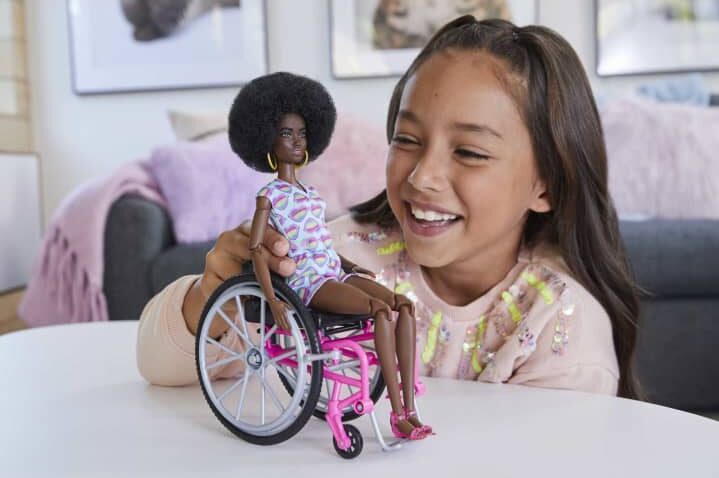In 1959, mother and co-founder of Mattel toy manufacturer, Ruth Handler, created a doll that would redefine play for generations of children to come: an unrealistically proportioned, outrageously beautiful, impossibly accomplished woman who would come to be known by the mononym Barbie.
Handler’s family was closely tied in with the Mattel business—Ruth’s husband, Elliot, was her co-founder, and Barbie was inspired by Handler’s own daughter, Barbara. At the time, dolls were designed for girls to imagine themselves as one thing—caregivers. Handler’s daughter had dreams that were not represented by these toys.

Her son, Kenneth, had access to toys that allowed him to imagine all kinds of careers like a firefighter, an astronaut, etc. In order to provide her daughter with a similar outlet for imagination, Handler decided to create a three-dimensional fashion doll for girls. Traditional fashion dolls were made of paper and came in packets resembling sticker books. Like the paper dolls, Barbie could be dressed and redressed to fit all the latest fashion trends.
Handler’s colleagues at Mattel were not enthusiastic about the idea. They were skeptical of a doll designed to look like an adult woman. Typical fashion dolls were flat-chested with stocky limbs and chubby cheeks, like toddlers, and leaders at Mattel did not believe that Handler’s vision of an adult doll, with breasts, would be financially successful. They could not have anticipated that this small step toward creative freedom for young girls would someday become one of American culture’s most profitable and iconic symbols.
From Gag to Trailblazer
But Handler wasn’t ready to give up and kept working on the idea on her own. On a vacation in Switzerland, she stumbled upon a sexy call girl named Bild Lilli who showed her the way. Standing 11.5 inches tall with a bright blond ponytail and a distinctly mature body, here was the plastic doll that would inspire Barbie.

The Bild Lilli doll was sold as a gag gift, primarily for men. The character began in a one-off comic strip created by Reinhard Beuthien for the German tabloid Bild, which turned into a regular column, which turned into the doll. To Handler, Bild Lilli’s size, shape, and ability to easily swap outfits made her the perfect prototype.

Ruth brought the doll to consumers, and the first Barbie officially debuted on March 9, 1959, at the New York Toy Fair. Like Margot Robbie in the teaser trailer for the upcoming film, this Barbie donned a simple black-and-white striped swimsuit and glamorous red lipstick. And although the men present, like the Mattel executives, were not fans of Barbie, women bought them for their daughters.
Two years later, on March 11, 1961, the Ken doll was introduced, with Ruth Handler’s son, Kenneth, serving as his namesake. Ken is attractive and accomplished (the Barbie website denotes him as a businessman, Olympian, pilot, and Pisces, among other things), but always on the sidelines next to the prolific Barbie.
As she grew in popularity, Barbie became more than just a children’s toy: She emerged from her plastic wrappings to become a powerful symbol of womanhood for the girls who played with her, just as Handler intended. Barbie kept up with global events, embracing different careers and interests as they became news headlines. In the 1960s, Barbie’s careers included: fashion editor, executive, and student teacher, alongside the more traditionally-gendered roles of teenage fashion model and singer.
Unlike women of the time, who were limited by laws that prevented them from doing things like accessing their own lines of credit, she was both a mirror for the progress made and a vision for what could be. Barbie bought her own house in 1962. She went to the Moon in 1965, four years before Neil Armstrong landed there, and eighteen years before Sally Ride would become the first American woman in space. However, it had already been two years since Valentina Tereshkova, a woman from the then Soviet Union, blasted off in 1963. Barbie made progressive strides within the American culture that embraced the 1960s housewife figure, but Mattel still had room to improve.
Broadening the Appeal
In 1980, Mattel released the first Barbies who were Black and Hispanic. In the past, Mattel had released diverse fashion dolls, but they were portrayed only as “Friends of Barbie. ” Although the dolls were similar to the original in many ways, before 1980, the title “Barbie” was used only for the white doll. Today’s Barbies feature distinct and varying identities, with some, like the Día De Muertos doll and Lunar New Year doll, focusing specifically on cultural traditions from the global majority.
1985 saw the introduction of the Girls Can Do Anything campaign, a series of ads including a commercial in which girls of various ethnicities were reminded they could “dream anything” and “do anything,” just like Barbie. It featured clips of girls doing everything from carrying their moms’ briefcases to staring into a microscope.
Current audiences may remember a modern campaign, from 2015, in which a hidden camera captured audiences’ reactions to young girls stepping into the shoes of real professionals: professors, paleontologists, and coaches, among others. The girls took over the jobs of real women: lecturing, studying, and coaching, only for the commercial to reveal that it was all just play. Barbie was a vehicle for the girls’ own interests and dreams, allowing them to fully immerse themselves in an imaginary life.
According to Mattel’s website, Barbie “recognizes girl-relevant careers in which women are traditionally underrepresented to show girls that they can be anything and to encourage discovery and exploration through play.” Mattel has produced Barbies with hundreds of different careers, demonstrating every career can be “girl-relevant.” Barbie herself has held over 200 different jobs, from a chief sustainability officer to a robotics engineer to a pop star.
Six-year-old Mila Feathers told Worth she appreciates that Barbie wears many hats. When asked what she likes about Barbies, she listed three things, “They can be anything, they can live in anything, [and] they can use anything.”
Her mother, Diane Feathers, a middle school Reading teacher, also celebrates the universality of the modern Barbie. She told Worth, “[When I was growing up,] all of the Barbies were stick-thin…they had larger chests, the waists were so tiny, and they had that unrealistic body type. Now, there’s so many different sizes and shapes of Barbies, and I think that’s amazing.”

In the late 2010s, Mattel expanded its diversity and inclusivity initiatives: in 2015, it launched the Barbie Sheroes campaign which modeled Barbie dolls after accomplished women, many of them women of color. The Shereoes campaign featured icons like filmmaker Ava DuVernay and Head of Fashion at Instagram, Eva Chen. In 2018, the More Role Models line was released, which showcased additional inspirational women throughout history, like artist Frida Kahlo and NASA mathematician Katherine Johnson.
In addition, new body types were added to the Barbie line in 2016, likely in response to criticisms that the original Barbie’s body is anatomically impossible—and doesn’t even leave room for internal organs—creating unachievable beauty standards for young girls. The project was led by Evelyn Mazzocco, then head of the Barbie Brand, and introduced three new body types: petite, tall, and curvy. These Barbie types are still available for purchase, along with the original build.
From the late 1950s to today, feminism has seen many changes, and Barbie has been both representational and aspirational as women’s rights have expanded. The idea of Barbie was radical at its inception, and Barbie continued to be progressive in the feminist movement. Not only was Barbie an icon of the times, she was often achieving things that non-plastic women wouldn’t do for years. She has been running for president every year since 1992, and in the movie, Barbie (played by Issa Rae) holds the office. Aside from promoting powerful women of the time, Barbie is a symbol of what could be. She can mirror what reality looks like and provide inspiration for the future.
Today, Barbie can represent just about anyone—not only the children who originally may have just been excited to see a doll that looked like an adult woman, but also the children of modern times who have the digital pathways to learn about the vastness of the world as they grow. Mattel continues to build out the universality that has allowed Barbie to become so ubiquitous with children’s toys. Barbie can have any skin tone or hair type. She can have any job imaginable. She might use a wheelchair or a hearing aid. Regardless of her individuality, she is Barbie. In the words of the official Barbie movie poster, “She’s everything.”








